布兰查德blancard宏观经济学课后习题答案(英文版)第二版
布兰查德课后习题答案(1-13章)(毕博).doc
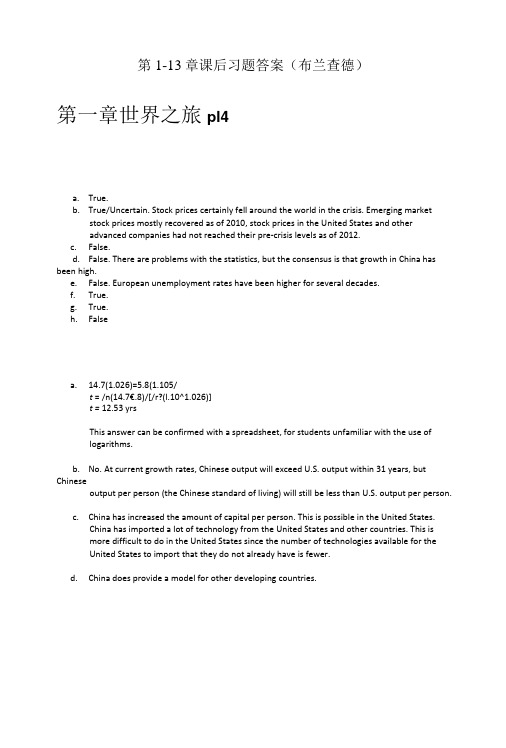
第1-13章课后习题答案(布兰查德)第一章世界之旅pl4a.True.b.True/Uncertain. Stock prices certainly fell around the world in the crisis. Emerging marketstock prices mostly recovered as of 2010, stock prices in the United States and otheradvanced companies had not reached their pre-crisis levels as of 2012.c.False.d.False. There are problems with the statistics, but the consensus is that growth in China has been high.e.False. European unemployment rates have been higher for several decades.f.True.g.True.h.Falsea.14.7(1.026)=5.8(1.105/t= /n(14.7€.8)/[/r?(l.10^1.026)]t = 12.53 yrsThis answer can be confirmed with a spreadsheet, for students unfamiliar with the use oflogarithms.b.No. At current growth rates, Chinese output will exceed U.S. output within 31 years, but Chineseoutput per person (the Chinese standard of living) will still be less than U.S. output per person.c.China has increased the amount of capital per person. This is possible in the United States.China has imported a lot of technology from the United States and other countries. This ismore difficult to do in the United States since the number of technologies available for theUnited States to import that they do not already have is fewer.d.China does provide a model for other developing countries.第二章本书之旅p38第1题a.True/Uncertain. Real GDP increased by a factor of 5; nominal GDP increased by afactor of 28. We usually think of GDP in real termsb.False.c.True.d.False. The level of the CPI means nothing. The rate of change of the CPI is one measure of inflation.e.Uncertain. Which index is better depends on what we are trying to measure—inflation faced by consumers or by the economy as a whole.f.Trueg.Trueh.Falsei.False. The Phillips curve is a relation between the change in inflation and the level ofunemployment.第4题a.2005 GDP: 10($2z000)+4($l,000)+1000($l)=$25,0002006 GDP: 12($3,000)+6($500)+1000($l)=$40,000 Nominal GDP has increased by 60%.b.2005 real (2005) GDP: $25,0002006 real (2005) GDP: 12($2,000)+6($l z000)+1000($l)=$31,000Real (2006) GDP has increased by 24%.c.2005 real (2006) GDP: 10($3,000)+4($500)+l,000($l)=$33,0002006 real (2006) GDP: $40,000.Real (2006) GDP has increased by 21.2%.d.The answers measure real GDP growth in different units. Neither answer is incorrect,just as measurement in inches is not more or less correct than measurement incentimeters.第5题a.2005 base year:b.Deflator(2005)=l; Deflator(2006)=$40,000/$31,000=1.29 lnflation=29%c.2006 base year:Deflator(2005)=$25,000/$33,000=0.76; Deflator(2006)=llnflation=(l-0.76)/0.76=.32=32%d.Analogous to 4d.第6题a.2005 real GDP = 10($2,500) + 4($750) + 1000($l) = $29,0002006 real GDP = 12($2,500) + 6($750) + 1000($l) = $35,500b.(35,500-29,000)/29,000 = .224 = 22.4%c.Deflator in 2005=$25,000/$29,000=.86Deflator in 2006=$40,000/$35z500=1.13Inflation = (1.13 -.86)/.86 = .31 = 31%.a.Yes, see appendix for further discussion.第三章商品市场p64a.True.b.False. Government spending excluding transfers was 20.4% of GDP.c.False. The propensity to consume must be less than one for our model to make sense.d.True.e.False.f.False. The increase in equilibrium output is one times the multiplier.g.False.a.Output will fall.b.Since output falls, investment will also fall. Public saving will not change. Privatesaving will fall, since investment falls, and investment equals saving. Since output andconsumer confidence fall, consumption will also fall.c.Output, investment, and private saving would have risen.d.Clearly this logic is faulty. When output is low, what is needed is an attempt byconsumers to spend more. This will lead to an increase in output, and therefore—somewhat paradoxically—to an increase in private saving. Note, however,that with a linear consumption function, the private saving rate (private savingdivided by output) will fall when c0 rises.第四章金融市场p86a.False.b.False.c.False. Money demand describes the portfolio decision to hold wealth in the form ofmoney rather than in the form of bonds. The interest rate on bonds is relevant to thisdecision.d.True.e.False.f.False.g.True.h.True.a.8° = 50,000-60,000 (.35-i)If the interest rate increases by 10 percentage points, bond demand increases by $6,000.b.An increase in wealth increases bond demand, but has no effect on money demand, whichdepends on income (a proxy for transactions demand).c.An increase in income increases money demand, but decreases bond demand, since weimplicitly hold wealth constant.d.First of all, the use of "money" in this statement is colloquial. "Income" should be substituted for "money." Second, when people earn more income, their wealth does not change right away. Thus, they increase their demand for money and decrease their demand for bonds.a.All money is in checking accounts, so demand for central bank money equals demand forreserves. Therefore, demand for central bank money=0.1($Y)(.8-4/).b.$1000 = 0.1($5,000B)(.8-4/)上15%c.Since the public holds no currency, money multiplier = 1/reserve ratio =M=(10)$1000=$l,0000M= M d at the interest derived in part (b).d.If H increases to $300B the interest rate falls to 5%.e.The interest rate falls to 5%, since when H equals $3000, M=(10)$300B=$3,0000.a.True.b.True.c.False.d.e. False.f.第五章商品市场和金融市场pl07False. The balanced budget multiplier is positive (it equals one), so the IS curve shifts right. Uncertain. An increase in government spending leads to an increase in output (which tends to increase investment), but also to an increase in the interest rate (which tends to reduce investment).g. True.a.y=C+/+G=200+.25(r-200)+150+.25M000/+25001100-2000,b.M/P= 1600=2 r-8000//= W00-1/5c.Substituting from part (b) into part (a) gives X=1000.d.Substituting from part (c) into part (b) gives /=5%.e.C=400; /=350; G=250; C+/+G=1000f./=1040; /=3%; C=410; /=380. A monetary expansion reduces the interest rate and increasesoutput. Consumption increases because output increases. Investment increases becauseoutput increases and the interest rate decreases.g./=1200; /=10%; C=450; /=350. A fiscal expansion increases output and the interest rate.Consumption increases because output increases. Investment is affected in two ways: theincrease in output tends to increase investment, and the increase in the interest rate tendsto reduce investment. In this example, these two effects exactly offset one another, andinvestment does not change.第六章劳动力市场pl32第1题a.False. The participation rate has increased over time.b.False.c.False.d.True.e.False.f.Uncertain/False. The degree of bargaining power depends on the nature of the job andthe employee's skills.g.True.h.False.a.W/P=l/(l+|i)=V1.05=0.952b.Wage setting: u=l-W/P=l-0.952=4.8%c.W/P=l/l・l=・91; u=l-.91=9%. The increase in the markup lowers the real wage.Algebraically, from the wage-setting equation, the unemployment rate must rise for the realwage to fall. So the natural rate increases. Intuitively, an increase in the markup impliesmore market power for firms, and therefore less production, since firms will use theirmarket power to increase the price of goods by reducing supply. Less production impliesless demand for labor, so the natural rate rises.第七章所有市场集中:AS-AD曲线pl60a.True.b.True. In the AS relation, if P=P e/Y=Y n. Note that P e must be known to graph the AS curve.c.False. The AD curve slopes down because an increase in P leads to a fall in M/P, so thenominal interest rate increases, and / and Y fall.d.False. There are changes in autonomous expenditure and supply shocks, both of whichcause output to deviate from the natural level in the short run.e.True.f.False. Fiscal policy affects the interest rate in the medium run and therefore affectsinvestment.g.False. The natural level of output changes in response to a permanent supply shock(other than a change in P3). The price level changes in the medium run in response toeither a demand or a supply shock.第4题a.Money is neutral in the sense that the nominal money supply has no effect onoutput or the interest rate in the medium run. Output returns to its natural level.The interest rate is determined by the position of the IS curve and the natural levelof output. Despite the neutrality of money in the medium run, an increase in themoney supply will increase output and reduce the interest rate in the short run.Therefore, expansionary monetary policy can be used to speed up the economy'sreturn to the natural level of output when output is low.b.In the medium run, fiscal policy affects the interest rate and investment, so fiscal policy is not considered neutral.c.False. Labor market policies, such as the degree of unemployment insurance, can affect thenatural level of output.a.SR:short runMR: medium runb-c.C I Private SSR falls ambiguous ambiguousMR Increasesfrom SR butstill lowerthanoriginallevel rises (aboveoriginallevel)rises (aboveoriginal level)In the medium run, consumption must lower than its original level because disposableincome is unchanged, but consumer confidence is lower.The short-run change in investment is ambiguous, because the interest rate falls,whichtends to increase investment, but output also falls, which tends to reduceinvestment. Inthe medium run, investment must rise (as compared to its short-run and originallevels),because the interest rate falls but output returns to its original level.Since the budget deficit does not change in this problem, the change in privatesaving equals the change in investment. It is possible that private saving will fall inthe short run, but private saving must rise (above its short-run and original levels) inthe medium run.第八章菲利普斯曲线、自然失业率和通货膨胀P182第1题a.True.b.False.c.False.d.True.e.False.f.True.g.Falseh.Falsei.Truej.True第 4 题.The neutrality of money revisitedc.5% per yeard.0% per yeare.Output growth is zero (the economy is at a constant natural level of output).第九章次贷危机(略)第十章增长的事实第1题,快速测试a.True.b.False.c.Uncertain 一earlier evidence suggested this was false but more recent evidencesuggests it may be true.d.False.e.True.f.False.g.True.第3题a.r=63b./doubles.c.Yes.d.Y/N=(K/N)也e.K/N=4 implies Y/N=2. K/N=8 implies Y/N=2.83. Output less than doubles.f.No.g.No. In part (f), we are essentially looking at what happens to output when we increasecapital only, not capital and labor in equal proportion. There are decreasing returns tocapital.h.Yes.第十一章储蓄、资本积累和产出P248第1题,快速测试a.True, in a closed economy, and if saving includes public and private saving.b.False.c.True. In the model without depreciation, there is no steady state. A constant savingrate produces a positive but declining rate of growth. In the infinite-time limit, thegrowth rate equals zero. Output per worker rises forever without bound. In themodel with depreciation, if the economy begins with a level of capital per workerbelow the steady-state level, a constant saving rate also produces a positive butdeclining rate of growth, with a limit of zero. In this case, however, output perworker approaches a fixed number, defined by the steady-state condition of theSolow model. Note that depreciation is not needed to define a steady state if themodel includes labor force growth or technological progress.d.Uncertain. See the discussion of the golden-rule saving rate.e.Uncertain/False. It is likely that the U.S. rate is below the golden rule rate and thattransforming Social Security to a pay-as-you-go system would ultimately increase theU.S. saving rate. These premises imply that such a transformation would increase U.S.consumption in the future, but not necessarily in the present. Indeed, if the onlyeffect of such a transformation is to increase the saving rate, we know thatconsumption per worker will fall in the short run. Moreover; moving to a pay-as-you-go system requires transition costs. If these costs are borrowed, then the reductionin public saving will offset the increase in private saving during the transition. If thesecosts are not borrowed, then transitional generations must suffer either a reductionin promised benefits or an increase in taxes to finance their own retirement inaddition to the retirement of a previous generation. Thus, whether the U.S. "should"move to a pay-as-you-go system depends on the likely resolution ofintergenerational distributional issues and your view about the equity of such aresolution.f.Uncertain. The U.S. capital stock is below the golden rule, but that does not necessarily imply that there should be tax breaks for saving. Even if the tax breaks were effective in stimulating saving, the increase in future consumption would come at the cost of current consumption.g False. Even if you accept the premise that educational investment increases output, it doesnot necessarily follow that countries should increase educational saving, since futureincreases in output will come at the expense of current consumption. Of course,there are other arguments for subsidizing education, particularly for low-incomehouseholds.第9题b.K/N = (0.15/.075)2 = 4y/N= (4 严=2c.K/N=(0.M)・075)2 =7.11y/N=(7.11 严=2.67Capital per worker and output per worker increase.第十二章技术进步与增长P266第1题,快速测试a.True.b.True.c.False. In steady state, there is no growth of output per effective worker.d.True.e.False. The steady-state rate of growth of output per effective worker is zero. A highersaving rate leads to higher steady-state level of capital per effective worker, but hasno effect on the steady-state rate of growth of output per effective worker.f.True.g.False.h.False/Uncertain. Even pessimists about technological progress typically argue that therate of progress will decline, not that it will be zero. Strictly, however, the truth ofthis statement is uncertain, because we cannot predict the future.i.False, rapid growth in China has been due to both increases in technology and increases incapital.a.i. K/(AN) = (s/(8+g.+g/v))2 = 1ii.Y/(AN)“K/AN)Jiii.g伽N)=0iv.g Y/N= g*%v.g产g/gN=6%b.i. K/(AN) = (s/(8+g A+g N))2 = 0.64ii.Y/(AN)“K/AN)W=0.8iii.g伽N)=0iv.g Y/N= g.=8%v.g产g/g/lO%An increase in the rate of technological progress reduces the steady-state levels of capital and output per effective worker, but increases the rate of growth of output per worker.c.i. K/SN) = (s/0+gA+gN))2=O.64ii.Y/(AN)“K/AN)也=0.8iii.g伽N)=0iv.g Y/N= g*%v.g户gn+gg 10%People are better off in case a. Given any set of initial values, the level of technologyis the same in cases (a) and (c), but the level of capital per effective worker is higherat every point in time in case (a). Thus, since Y/N=AY/(AN)=A(K/(AN))V2=A}/z(K/N)V2,output per worker is always higher in case (a)-a.Probably affects A. Think of climate.b.Affects H and possibly A, if better education improves the fertility of research.c.Affects A. Strong protection tends to encourage more R&D but also to limit diffusionof technology.d.May affect A through diffusion.e.May affect K, H, and A. Lower tax rates increase the after-tax return on investment,and thus tend to lead to more accumulation of K and H and to more R&D spending.f.If we interpret K as private capital, then infrastructure affects A (e.g., bettertransportation networks may make the economy more productive by reducingcongestion time).g.Assuming no technological progress, a reduction in population growth implies anincrease in the steady-state level of output per worker. A reduction in populationgrowth leads to an increase in capital per worker. If there is technological progress,there is no steady-state level of output per worker. In this case, however, a reductionin population growth implies that output per worker will be higher at every point intime, for any given path of technology. See the answer to problem 6(c).第十三章技术进步、短期和长期p288第1题a.False. Productivity growth is unrelated to the natural rate of unemployment. If theunemployment rate is constant, employment grows at same rate as the labor force.b.False.c.True.d.True.e.True.f.True.g.False.h.False第3题An increase in labor productivity has no effect on the natural rate of unemployment, because the wage ultimately rises to capture the added productivity. The increase in the wage also implies that an increase in labor productivity has no permanent effect on inflation. From the price setting equation,P=(l+ rr\)W/A. If the wage (W) increases by the same proportion as productivity (A), the price level will not change.。
宏观经济学第二版习题答案
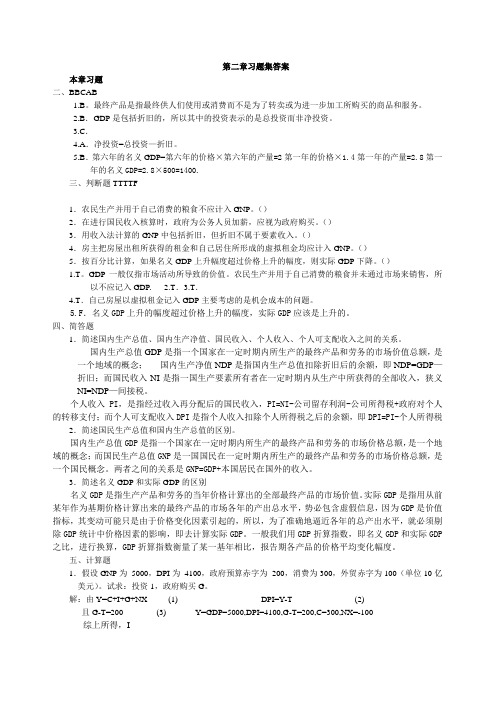
第二章习题集答案本章习题二、BBCAB1.B。
最终产品是指最终供人们使用或消费而不是为了转卖或为进一步加工所购买的商品和服务。
2.B.GDP是包括折旧的,所以其中的投资表示的是总投资而非净投资。
3.C.4.A.净投资=总投资—折旧。
5.B.第六年的名义GDP=第六年的价格×第六年的产量=2第一年的价格×1.4第一年的产量=2.8第一年的名义GDP=2.8×500=1400.三、判断题TTTTF1.农民生产并用于自己消费的粮食不应计入GNP。
()2.在进行国民收入核算时,政府为公务人员加薪,应视为政府购买。
()3.用收入法计算的GNP中包括折旧,但折旧不属于要素收入。
()4.房主把房屋出租所获得的租金和自己居住所形成的虚拟租金均应计入GNP。
()5.按百分比计算,如果名义GDP上升幅度超过价格上升的幅度,则实际GDP下降。
()1.T。
GDP一般仅指市场活动所导致的价值。
农民生产并用于自己消费的粮食并未通过市场来销售,所以不应记入GDP. 2.T.3.T.4.T.自己房屋以虚拟租金记入GDP主要考虑的是机会成本的问题。
5.F.名义GDP上升的幅度超过价格上升的幅度,实际GDP应该是上升的。
四、简答题1.简述国内生产总值、国内生产净值、国民收入、个人收入、个人可支配收入之间的关系。
国内生产总值GDP是指一个国家在一定时期内所生产的最终产品和劳务的市场价值总额,是一个地域的概念;国内生产净值NDP是指国内生产总值扣除折旧后的余额,即NDP=GDP—折旧;而国民收入NI是指一国生产要素所有者在一定时期内从生产中所获得的全部收入,狭义NI=NDP—间接税。
个人收入PI,是指经过收入再分配后的国民收入,PI=NI-公司留存利润-公司所得税+政府对个人的转移支付;而个人可支配收入DPI是指个人收入扣除个人所得税之后的余额,即DPI=PI-个人所得税2.简述国民生产总值和国内生产总值的区别。
布兰查德《宏观经济学》课后习题及详解(预期、消费和投资)【圣才出品】

第16章预期、消费和投资一、概念题1.平行数据集(panel data sets)答:平行数据集又称“面板数据集”,是一个包含很多个人或很多公司的一个或多个变量值的时序数据集,即不同实体在不同时期被观测的数据集合,可以用于分析各样本在时间序列上组成的数据的特征。
平行数据集能够综合利用样本信息,通过模型中的参数既可以分析个体之间的差异情况,又可以描述个体的动态变化特征。
其优点在于:①消除个别变异;②更多的信息,更多的自由度,更有效的估计,更少的共线性;③可以描述实体的动态变化,正确理解变量之间的关系;④可以估计某些难以度量的因素对被解释变量的影响,可以研究更加复杂的行为;⑤样本增加,估计值更加趋近于真实值。
缺点在于:①数据的设计和收集存在一定问题;②误差失真等。
2.消费的持久收入理论(permanent income theory of consumption)答:消费的持久收入理论又称“消费的持久收入假说”,是美国经济学家M·弗里德曼提出的一种消费函数理论。
弗里德曼认为,人们的收入可以分为两部分:一部分是暂时性收入,即那些偶然性的、未预期到的临时性收入;另一部分是持久性收入,指消费者在较长时期可以维持的稳定收入水平。
人们在计划自己的消费水平时,不是依据短期的实际收入,而是把消费和长期的持久收入联系起来。
短期的可支配收入由于受许多偶然因素的影响,是一个经常变动的量,人们的消费不会随它的波动而经常变动。
消费者为了实现其效用最大化,实际上是根据他们在长期中能够保持的收入水平来进行消费的。
暂时性的短期收入变动只有在能够影响持久收入水平预期时,才能影响消费水平。
因此,消费是持久收入的函数。
持久收入是消费者一生中的稳定收入,这种稳定收入可以理解为消费者一生收入总和的某种平均数。
消费者在其生命终结之前无法准确知道其持久收入,持久收入也无法直接观测到。
因此,消费者只能根据某种方法,利用可得到的信息,对其持久收入进行估计。
宏观经济学第二版课后习题参考答案
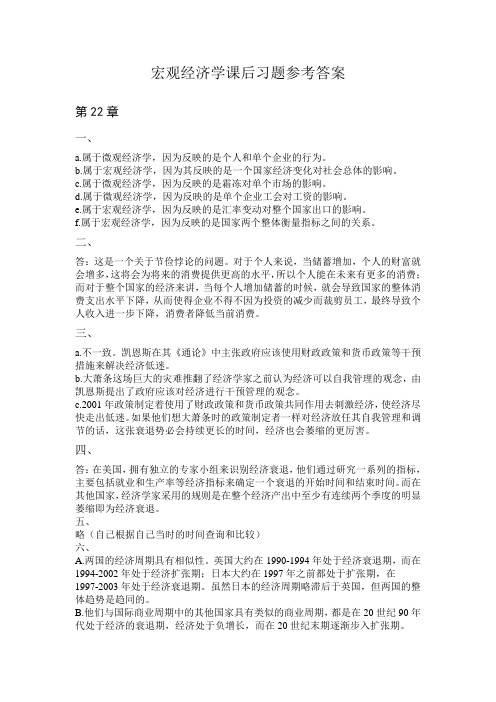
宏观经济学课后习题参考答案第22章一、a.属于微观经济学,因为反映的是个人和单个企业的行为。
b.属于宏观经济学,因为其反映的是一个国家经济变化对社会总体的影响。
c.属于微观经济学,因为反映的是霜冻对单个市场的影响。
d.属于微观经济学,因为反映的是单个企业工会对工资的影响。
e.属于宏观经济学,因为反映的是汇率变动对整个国家出口的影响。
f.属于宏观经济学,因为反映的是国家两个整体衡量指标之间的关系。
二、答:这是一个关于节俭悖论的问题。
对于个人来说,当储蓄增加,个人的财富就会增多,这将会为将来的消费提供更高的水平,所以个人能在未来有更多的消费;而对于整个国家的经济来讲,当每个人增加储蓄的时候,就会导致国家的整体消费支出水平下降,从而使得企业不得不因为投资的减少而裁剪员工,最终导致个人收入进一步下降,消费者降低当前消费。
三、a.不一致。
凯恩斯在其《通论》中主张政府应该使用财政政策和货币政策等干预措施来解决经济低迷。
b.大萧条这场巨大的灾难推翻了经济学家之前认为经济可以自我管理的观念,由凯恩斯提出了政府应该对经济进行干预管理的观念。
c.2001年政策制定着使用了财政政策和货币政策共同作用去刺激经济,使经济尽快走出低迷。
如果他们想大萧条时的政策制定者一样对经济放任其自我管理和调节的话,这张衰退势必会持续更长的时间,经济也会萎缩的更厉害。
四、答:在美国,拥有独立的专家小组来识别经济衰退,他们通过研究一系列的指标,主要包括就业和生产率等经济指标来确定一个衰退的开始时间和结束时间。
而在其他国家,经济学家采用的规则是在整个经济产出中至少有连续两个季度的明显萎缩即为经济衰退。
五、略(自己根据自己当时的时间查询和比较)六、A.两国的经济周期具有相似性。
英国大约在1990-1994年处于经济衰退期,而在1994-2002年处于经济扩张期;日本大约在1997年之前都处于扩张期,在1997-2003年处于经济衰退期。
虽然日本的经济周期略滞后于英国,但两国的整体趋势是趋同的。
布兰查德《宏观经济学》课后习题及详解(预期、产出和政策)【圣才出品】
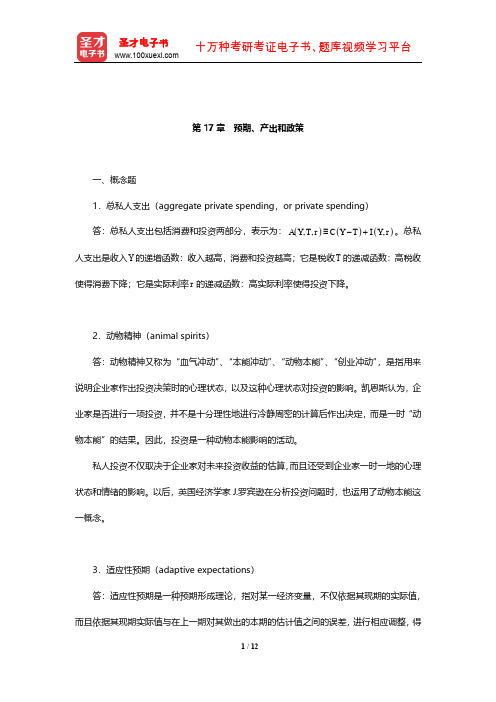
第17章 预期、产出和政策一、概念题1.总私人支出(aggregate private spending ,or private spending ) 答:总私人支出包括消费和投资两部分,表示为:。
总私人支出是收入的递增函数:收入越高,消费和投资越高;它是税收的递减函数:高税收使得消费下降;它是实际利率的递减函数:高实际利率使得投资下降。
2.动物精神(animal spirits )答:动物精神又称为“血气冲动”、“本能冲动”、“动物本能”、“创业冲动”,是指用来说明企业家作出投资决策时的心理状态,以及这种心理状态对投资的影响。
凯恩斯认为,企业家是否进行一项投资,并不是十分理性地进行冷静周密的计算后作出决定,而是一时“动物本能”的结果。
因此,投资是一种动物本能影响的活动。
私人投资不仅取决于企业家对未来投资收益的估算,而且还受到企业家一时一地的心理状态和情绪的影响。
以后,英国经济学家J.罗宾逊在分析投资问题时,也运用了动物本能这一概念。
3.适应性预期(adaptive expectations )答:适应性预期是一种预期形成理论,指对某一经济变量,不仅依据其现期的实际值,而且依据其现期实际值与在上一期对其做出的本期的估计值之间的误差,进行相应调整,得()()(),,,A Y T r C Y T I Y r ≡-+Y T r出对其未来估计值的预期。
适应性预期产生于20世纪50年代,是由菲利普·卡甘在一篇讨论恶性通货膨胀的文章中提出来的,很快在宏观经济学中得到广泛的应用。
适应性预期假定经济人根据以前的预期误差来修正以后的预期。
适应性预期模型的要点是预期变量依赖于该变量的历史信息。
某个时期的适应性预期价格等于上一时期预期的价格加上常数与上期价格误差(上个时期实际价格与预期价格之差)之和。
即预期价格是过去所有实际价格的加权平均数,权数是常数的函数。
适应性预期在物价较为稳定的时期能较好地反映经济现实。
布兰查德《宏观经济学》章节课后习题详解(财政政策:一个总结)【圣才出品】
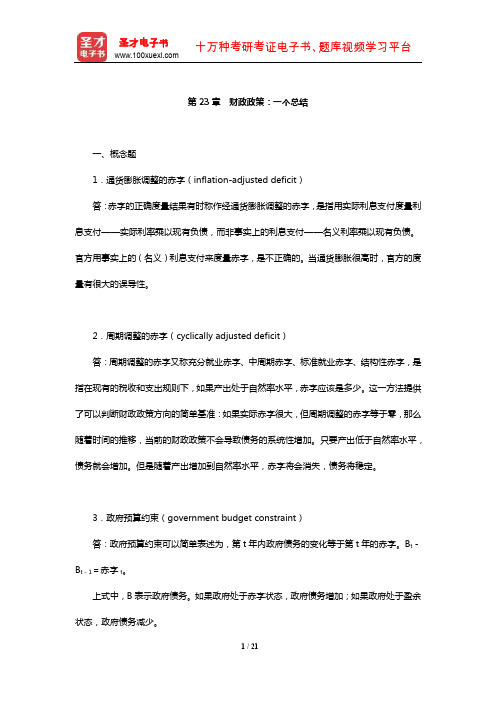
第23章财政政策:一个总结一、概念题1.通货膨胀调整的赤字(inflation-adjusted deficit)答:赤字的正确度量结果有时称作经通货膨胀调整的赤字,是指用实际利息支付度量利息支付——实际利率乘以现有负债,而非事实上的利息支付——名义利率乘以现有负债。
官方用事实上的(名义)利息支付来度量赤字,是不正确的。
当通货膨胀很高时,官方的度量有很大的误导性。
2.周期调整的赤字(cyclically adjusted deficit)答:周期调整的赤字又称充分就业赤字、中周期赤字、标准就业赤字、结构性赤字,是指在现有的税收和支出规则下,如果产出处于自然率水平,赤字应该是多少。
这一方法提供了可以判断财政政策方向的简单基准:如果实际赤字很大,但周期调整的赤字等于零,那么随着时间的推移,当前的财政政策不会导致债务的系统性增加。
只要产出低于自然率水平,债务就会增加。
但是随着产出增加到自然率水平,赤字将会消失,债务将稳定。
3.政府预算约束(government budget constraint)答:政府预算约束可以简单表述为,第t年内政府债务的变化等于第t年的赤字。
B t-B t-1=赤字t。
上式中,B表示政府债务。
如果政府处于赤字状态,政府债务增加;如果政府处于盈余状态,政府债务减少。
4.自动稳定器(automatic stabilizer)答:自动稳定器指经济活动对赤字的影响,衰退自然导致赤字增加,而赤字增加本身有发挥财政扩张的作用,这将会部分地抵消衰退。
一些财政支出和税收制度就具有某种自动调整经济的灵活性,可以自动配合需求管理,减缓总需求的波动性,从而有助于经济的稳定。
在社会经济生活中,通常具有内在稳定器作用的因素主要包括:个人和公司所得税、失业补助和其他福利转移支付、农产品维持价格以及公司储蓄和家庭储蓄等。
例如,在萧条时期,个人收入和公司利润减少,政府所得税收入自动减少,从而相应增加了消费和投资。
宏观经济学布兰查德后作业答案
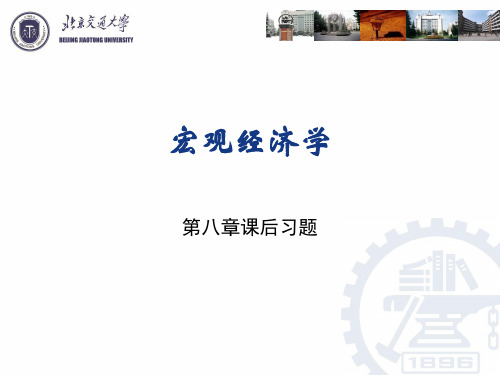
分别为0.09、0.09
c.第1年到第2年、第2年到第3年、第3年到第4年之间,通货 膨胀率是多少?
根据公式:π=(Pt-Pt-1)/Pt-1 第1年到第2年:π=(100-95.2)/95.2=0.05
e.计算中期的失业率和通货膨胀率。
中期,失业率回到自然失业率5%,产出等于正常 增长率3%,通货膨胀等于调整的名义货币增长 率3%-3%=0。
f.“通货膨胀总是一个货币现象”是对中期还是短 期的描述。
在中期内,失业率等于自然失业率,产出以正常 增长率增长。名义货币增长决定通货膨胀率:名 义货币增长1%导致通货膨胀增加1%。
c.你相信问题(b)中的答案吗?为什么?(提示: 考虑人们如何形成通货膨胀预期。)
不相信。因为(b)中的前提是π et= 0,而πt永远 等于4%,意味着人们未来的预期通胀都为零,仅 仅用过去的通胀水平表示未来的通胀水平而不加 任何修正,而且这样通胀预期将会永远维持下去 。但是因为预期通货膨胀率是由通货膨胀率决定 的,所以正的π t不可能永远只产生等于零的π et。 事实上,人们不可能犯这样的系统性错误,因而 (b)中的答案是不可能的。
t+2
-0.7%
8.8%
t+3
-3.2%
7.5%
t+4
-4.1%
5.9%
t+5
-3.5%
4.4%
t+6
-3.1%
3.6%
t+7
-0.5%
3.4%
t+8
宏观经济学英文版课后题答案
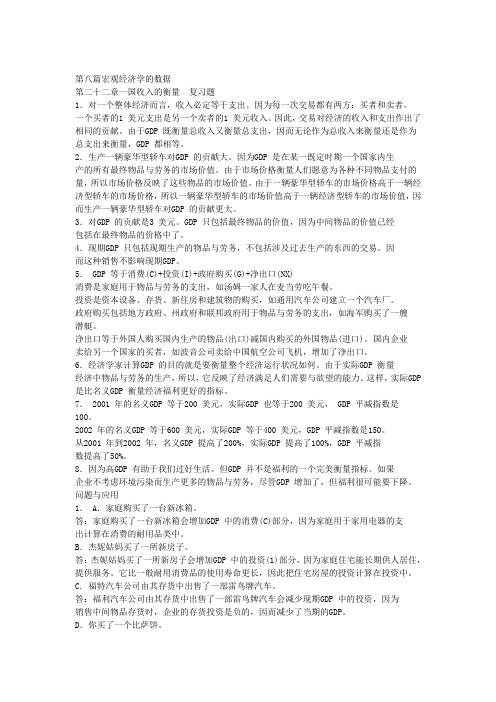
第八篇宏观经济学的数据第二十二章一国收入的衡量复习题1.对一个整体经济而言,收入必定等于支出。
因为每一次交易都有两方:买者和卖者。
一个买者的1 美元支出是另一个卖者的1 美元收入。
因此,交易对经济的收入和支出作出了相同的贡献。
由于GDP 既衡量总收入又衡量总支出,因而无论作为总收入来衡量还是作为总支出来衡量,GDP 都相等。
2.生产一辆豪华型轿车对GDP 的贡献大。
因为GDP 是在某一既定时期一个国家内生产的所有最终物品与劳务的市场价值。
由于市场价格衡量人们愿意为各种不同物品支付的量,所以市场价格反映了这些物品的市场价值。
由于一辆豪华型轿车的市场价格高于一辆经济型轿车的市场价格,所以一辆豪华型轿车的市场价值高于一辆经济型轿车的市场价值,因而生产一辆豪华型轿车对GDP 的贡献更大。
3.对GDP 的贡献是3 美元。
GDP 只包括最终物品的价值,因为中间物品的价值已经包括在最终物品的价格中了。
4.现期GDP 只包括现期生产的物品与劳务,不包括涉及过去生产的东西的交易。
因而这种销售不影响现期GDP。
5. GDP 等于消费(C)+投资(I)+政府购买(G)+净出口(NX)消费是家庭用于物品与劳务的支出,如汤姆一家人在麦当劳吃午餐。
投资是资本设备、存货、新住房和建筑物的购买,如通用汽车公司建立一个汽车厂。
政府购买包括地方政府、州政府和联邦政府用于物品与劳务的支出,如海军购买了一艘潜艇。
净出口等于外国人购买国内生产的物品(出口)减国内购买的外国物品(进口)。
国内企业卖给另一个国家的买者,如波音公司卖给中国航空公司飞机,增加了净出口。
6.经济学家计算GDP 的目的就是要衡量整个经济运行状况如何。
由于实际GDP 衡量经济中物品与劳务的生产,所以,它反映了经济满足人们需要与欲望的能力。
这样,实际GDP 是比名义GDP 衡量经济福利更好的指标。
7. 2001 年的名义GDP 等于200 美元,实际GDP 也等于200 美元, GDP 平减指数是100。
布兰查德《宏观经济学》课后习题及详解(开放经济中的物品市场)【圣才出品】
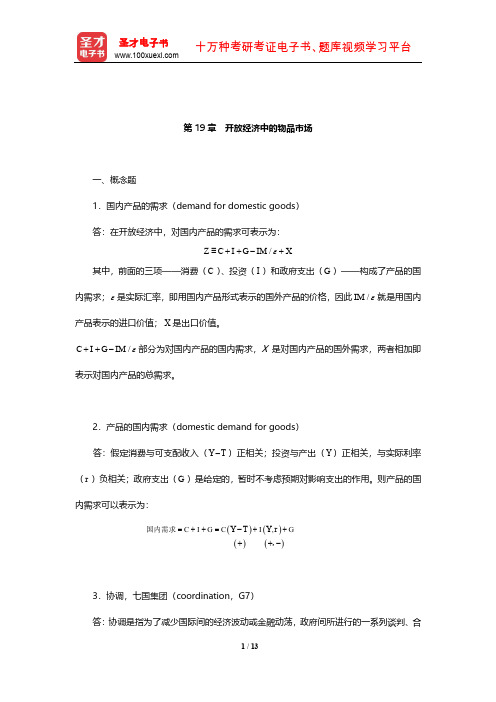
第19章 开放经济中的物品市场一、概念题1.国内产品的需求(demand for domestic goods )答:在开放经济中,对国内产品的需求可表示为:其中,前面的三项——消费()、投资()和政府支出()——构成了产品的国内需求;是实际汇率,即用国内产品形式表示的国外产品的价格,因此就是用国内产品表示的进口价值;是出口价值。
部分为对国内产品的国内需求,X 是对国内产品的国外需求,两者相加即表示对国内产品的总需求。
2.产品的国内需求(domestic demand for goods )答:假定消费与可支配收入()正相关;投资与产出()正相关,与实际利率()负相关;政府支出()是给定的,暂时不考虑预期对影响支出的作用。
则产品的国内需求可以表示为:3.协调,七国集团(coordination ,G7)答:协调是指为了减少国际间的经济波动或金融动荡,政府间所进行的一系列谈判、合/Z C I G IM X ε≡++-+C I G ε/IM εX /C I G IM ε++-Y T -Y r G ()()()(),国内需求 C I G C I GY T Y r =++=++-++-,作、妥协的过程。
从实际情况看,由于各国间的利益冲突,国家间的宏观协调非常有限。
这可能有以下原因:①协调就意味着一些国家可能比其他国家贡献得更多,但它们可能并不愿意这样做。
②假定只有一些国家处于衰退中,那些并没有处于衰退之中的国家可能就不愿意提高它们自己的需求;但是如果它们不这么做,那些扩张的国家相对于不扩张的国家就可能会出现贸易赤字。
③假定一些国家已经有巨大的贸易赤字。
这些国家可能就不愿意削减税收或者进一步提高支出,因为这样会更加提高它们的贸易赤字。
它们会要求其他国家作出更多的调整,然而其他的国家可能并不愿意这么做。
④各个国家都会承诺协调,然后并不实现其诺言。
一旦所有的国家都同意提高支出,那么,每一个国家都会有不实行的动机,以从其他国家的需求提高中获益,从而改善其贸易状况。
布兰查德《宏观经济学》章节课后习题详解(增长的事实)【圣才出品】
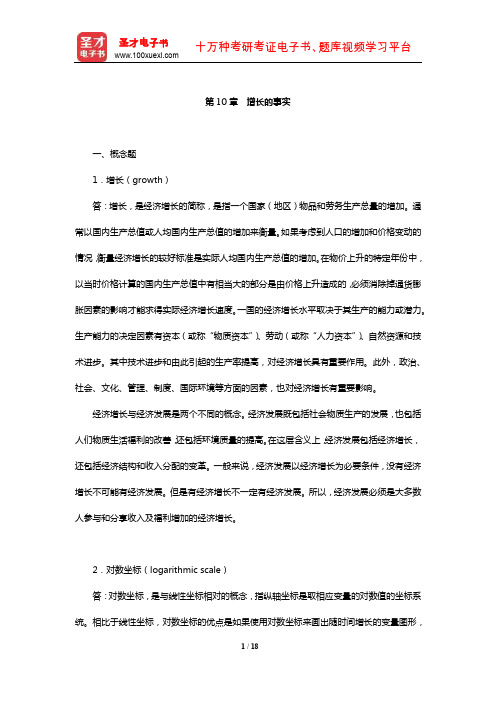
第10章增长的事实一、概念题1.增长(growth)答:增长,是经济增长的简称,是指一个国家(地区)物品和劳务生产总量的增加。
通常以国内生产总值或人均国内生产总值的增加来衡量。
如果考虑到人口的增加和价格变动的情况,衡量经济增长的较好标准是实际人均国内生产总值的增加。
在物价上升的特定年份中,以当时价格计算的国内生产总值中有相当大的部分是由价格上升造成的,必须消除掉通货膨胀因素的影响才能求得实际经济增长速度。
一国的经济增长水平取决于其生产的能力或潜力。
生产能力的决定因素有资本(或称“物质资本”)、劳动(或称“人力资本”)、自然资源和技术进步。
其中技术进步和由此引起的生产率提高,对经济增长具有重要作用。
此外,政治、社会、文化、管理、制度、国际环境等方面的因素,也对经济增长有重要影响。
经济增长与经济发展是两个不同的概念。
经济发展既包括社会物质生产的发展,也包括人们物质生活福利的改善,还包括环境质量的提高。
在这层含义上,经济发展包括经济增长,还包括经济结构和收入分配的变革。
一般来说,经济发展以经济增长为必要条件,没有经济增长不可能有经济发展。
但是有经济增长不一定有经济发展。
所以,经济发展必须是大多数人参与和分享收入及福利增加的经济增长。
2.对数坐标(logarithmic scale)答:对数坐标,是与线性坐标相对的概念,指纵轴坐标是取相应变量的对数值的坐标系统。
相比于线性坐标,对数坐标的优点是如果使用对数坐标来画出随时间增长的变量图形,通过考察斜率,可以容易地看到增长率发生的变化。
原因如下:假定一个变量随时间增长的增长率是常数(如每年3%),那么,变量越大,从一年到下一年增量就越大。
如果使用线性纵轴坐标来画出图形,增量将会随时间越变越大。
使用对数坐标,相同比例的增加由坐标轴上相同的垂直距离表示。
也就是说,当使用线性坐标时,以不变速度增长的变量行为就被表示为一条变得越来越陡峭的曲线;但使用对数坐标时,就被表示成了一条直线,而且直线的斜率等于增长率,比如说如果变量每年增长3%,直线的斜率就是0.03。
布兰查德《宏观经济学》课后习题及详解(物品市场和金融市场:IS-LM模型)【圣才出品】
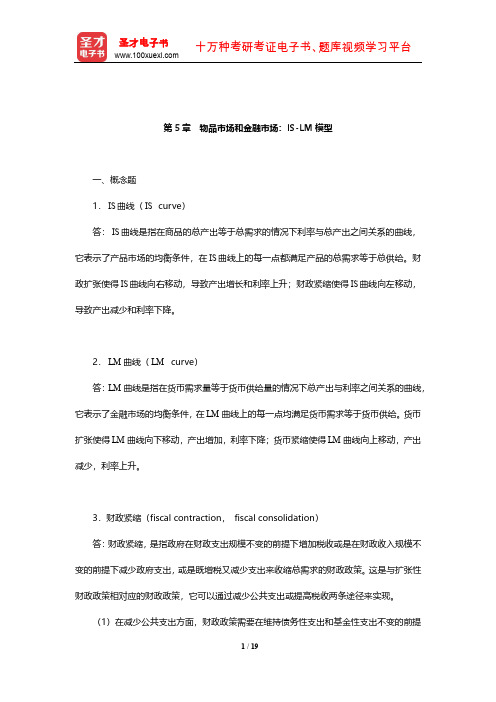
第5章物品市场和金融市场:IS-LM模型一、概念题1.IS曲线(IS curve)答:IS曲线是指在商品的总产出等于总需求的情况下利率与总产出之间关系的曲线,它表示了产品市场的均衡条件,在IS曲线上的每一点都满足产品的总需求等于总供给。
财政扩张使得IS曲线向右移动,导致产出增长和利率上升;财政紧缩使得IS曲线向左移动,导致产出减少和利率下降。
2.LM曲线(LM curve)答:LM曲线是指在货币需求量等于货币供给量的情况下总产出与利率之间关系的曲线,它表示了金融市场的均衡条件,在LM曲线上的每一点均满足货币需求等于货币供给。
货币扩张使得LM曲线向下移动,产出增加,利率下降;货币紧缩使得LM曲线向上移动,产出减少,利率上升。
3.财政紧缩(fiscal contraction,fiscal consolidation)答:财政紧缩,是指政府在财政支出规模不变的前提下增加税收或是在财政收入规模不变的前提下减少政府支出,或是既增税又减少支出来收缩总需求的财政政策。
这是与扩张性财政政策相对应的财政政策,它可以通过减少公共支出或提高税收两条途径来实现。
(1)在减少公共支出方面,财政政策需要在维持债务性支出和基金性支出不变的前提下,减少经常性支出和建设性支出。
为了减少经常性支出,政府需要压缩国家机关和人员的支出、非营利性社会事业及其人员的支出、社会保障体系及其人员的支出。
为了减少建设性支出,政府需要大力压缩公共工程支出。
当然,政府在压缩公共支出总量的同时,还要根据经济建设的需要调整公共支出的结构。
(2)在提高税收方面,紧缩性财政政策可以从扩大税基(如缩小减免税或退税的企业范围、降低个人所得税的收入起征点)和提高税率(如提高个人所得税累进税率和将企业的消费型增值税改为生产型增值税)两方面着手。
财政支出的减少和税收的提高,既直接减少了投资和消费需求,又通过降低民间的收入而间接收缩了消费需求。
在财政预算上,财政支出降低和税收提高同步进行,意味着财政盈余的出现或赤字的减少。
布兰查德《宏观经济学》章节课后习题详解(本书之旅)【圣才出品】
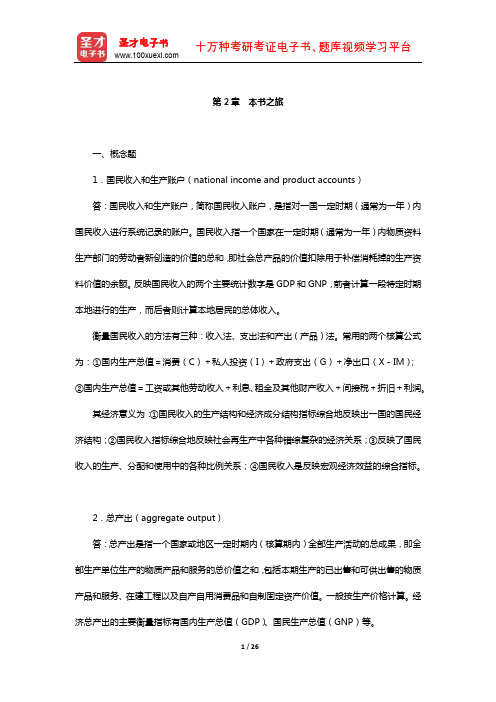
第2章本书之旅一、概念题1.国民收入和生产账户(national income and product accounts)答:国民收入和生产账户,简称国民收入账户,是指对一国一定时期(通常为一年)内国民收入进行系统记录的账户。
国民收入指一个国家在一定时期(通常为一年)内物质资料生产部门的劳动者新创造的价值的总和,即社会总产品的价值扣除用于补偿消耗掉的生产资料价值的余额。
反映国民收入的两个主要统计数字是GDP和GNP,前者计算一段特定时期本地进行的生产,而后者则计算本地居民的总体收入。
衡量国民收入的方法有三种:收入法、支出法和产出(产品)法。
常用的两个核算公式为:①国内生产总值=消费(C)+私人投资(I)+政府支出(G)+净出口(X-IM);②国内生产总值=工资或其他劳动收入+利息、租金及其他财产收入+间接税+折旧+利润。
其经济意义为:①国民收入的生产结构和经济成分结构指标综合地反映出一国的国民经济结构;②国民收入指标综合地反映社会再生产中各种错综复杂的经济关系;③反映了国民收入的生产、分配和使用中的各种比例关系;④国民收入是反映宏观经济效益的综合指标。
2.总产出(aggregate output)答:总产出是指一个国家或地区一定时期内(核算期内)全部生产活动的总成果,即全部生产单位生产的物质产品和服务的总价值之和,包括本期生产的已出售和可供出售的物质产品和服务、在建工程以及自产自用消费品和自制固定资产价值。
一般按生产价格计算。
经济总产出的主要衡量指标有国内生产总值(GDP)、国民生产总值(GNP)等。
3.国内生产总值(gross domestic product,GDP)答:国内生产总值是指一个国家(地区)的领土范围内,本国(地区)居民和外国居民在一定时期内所生产和提供的最终使用的产品和劳务的价值总和。
国内生产总值之所以称为总值,是因为它包含了生产中的固定资产消耗(固定资产折旧)。
其一般通过支出法、增值法和收入法三种方法进行核算。
布兰查德《宏观经济学》课后习题及详解(所有市场:AS-AD模型)【圣才出品】
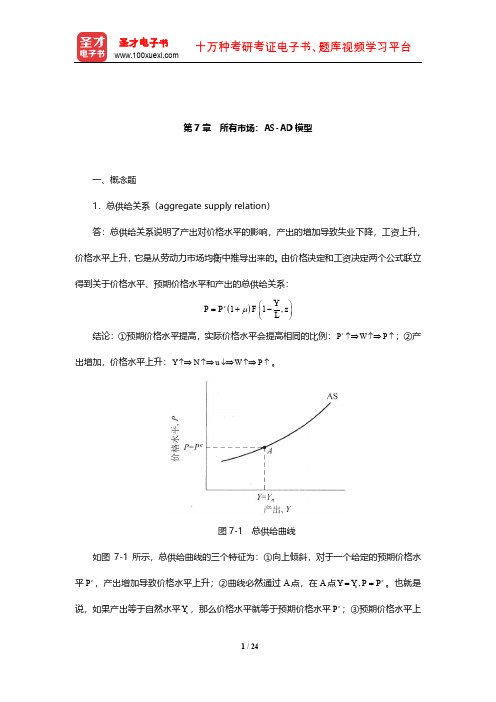
第7章 所有市场:AS-AD 模型一、概念题1.总供给关系(aggregate supply relation )答:总供给关系说明了产出对价格水平的影响,产出的增加导致失业下降,工资上升,价格水平上升,它是从劳动力市场均衡中推导出来的。
由价格决定和工资决定两个公式联立得到关于价格水平、预期价格水平和产出的总供给关系:()11,e Y P P F z L μ⎛⎫=+- ⎪⎝⎭ 结论:①预期价格水平提高,实际价格水平会提高相同的比例:e P W P ↑⇒↑⇒↑;②产出增加,价格水平上升:Y N u W P ↑⇒↑⇒↓⇒↑⇒↑。
图7-1 总供给曲线如图7-1所示,总供给曲线的三个特征为:①向上倾斜,对于一个给定的预期价格水平e P ,产出增加导致价格水平上升;②曲线必然通过A 点,在A 点,e n Y Y P P ==。
也就是说,如果产出等于自然水平n Y ,那么价格水平就等于预期价格水平e P ;③预期价格水平上升使得总供给曲线向上移动,相反,预期价格水平下降使得总供给曲线向下移动。
2.总需求关系(aggregate demand relation )答:总需求关系说明了价格水平对产出的影响,价格水平的上升减少了实际货币存量,提高了利率,减少了产出。
它是从物品和金融市场均衡推导而来。
(物品市场)IS :()(),Y C Y T I Y i G =-++;(金融市场)LM :()M YL i P=; 总需求曲线的表达式:,,M Y Y G T P -++⎛⎫ ⎪= ⎪⎝⎭产出是实际货币存量的增函数,政府支出的增函数和税收的减函数,其推导过程如图7-2所示。
图7-2(a )画出了IS 和LM 曲线,最初的均衡点为A 点。
当价格水平从P 上升到'P 时,LM 曲线向上移动。
均衡从A 点移动到'A 点,利率从i 上升到'i ,产出从Y 下降到'Y 。
价格水平上升导致产出下降。
《宏观经济学》课后答案(布兰查德版)
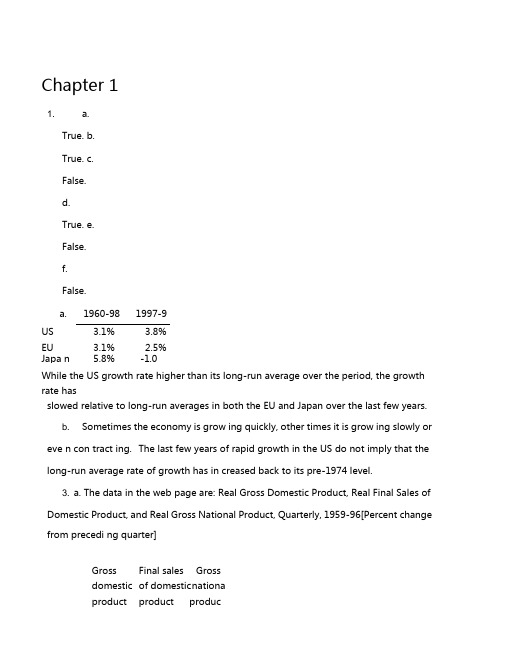
Chapter 11. a.True. b.True. c.False.d.True. e.False.f.False.a. 1960-98 1997-9US 3.1% 3.8%EU 3.1% 2.5%Japa n 5.8% -1.0While the US growth rate higher than its long-run average over the period, the growth rate hasslowed relative to long-run averages in both the EU and Japan over the last few years.b. Sometimes the economy is grow ing quickly, other times it is grow ing slowly or eve n con tract ing. The last few years of rapid growth in the US do not imply that the long-run average rate of growth has in creased back to its pre-1974 level.3. a. The data in the web page are: Real Gross Domestic Product, Real Final Sales of Domestic Product, and Real Gross National Product, Quarterly, 1959-96[Percent change from precedi ng quarter]Gross Final sales Grossdomestic of domestic n ationaproduct product product1959: I 8.6II 11.2III -0.3IV 1.71996: I 1.8II 6.0III 1.0IV 4.3 4.5 4. 9suggesting that recessi ons typically last two-three quarters and that the most severe recessi ons in that period were the recessi ons of 1974-75 and 1981-82.b. Perce ntage Chan gesin: Output GrowthIn flati on1968: 4.7I 7.5II 7.1III 3.0IV 1.81969: 3.0I 6.2II 1.0III 2.3IV -2.01970: 0.1I -0.7II 0.6III 3.7IV -3.91971: 3.3I 11.3II 2.3 4.III 2.6 4.IV 1.1 4.3If history simply repeats itself, the Un ited States might have a short recessi on (last ing perhaps oneyear) accompa nied by an accelerati on in the rate of in flati on by about one perce ntage poi nt.4. a. Banking services, bus in ess services.b. Not only has the relative dema nd for skilled workers in creased but the industries where this effect is the stron gest are maki ng up a greater fracti on of the economy.5. 1. Low un employme nt might lead to an in crease in in flati on.2. Although measureme nt error certa in ly con tributes to the measured slowdow nin growth, there are other issues to con sider as well, i ncludi ng the productivity of new research and accumulati on of new capital.3. Although labor market rigidities may be important, it is also important toconsider that these rigidities may not be excessive, and that high un employme nt may arise from flawed macroec ono mic policies.4. Although there were serious problems with regard to the management of Asian financial systems, it is important to consider the possibility that the flight of foreign capital from these coun tries worse ned the situati on by caus ing a severe stock market crash and excha nge rate depreciati on.5. Although the Euro will remove obstacles to free trade between Europeancountries, each country will be forced to give up its own monetary policy.* 6. a. From Chapter 1: US output 1997=$8b; China output 1996=$.84b. Note that China ' outputin 1997 is $(.84)*(1.09) b. Equating output for some time t in the future:8*(1.03)1(.84*1.09)*(1.09)匕/(.84*1.09)=(1.09/1.03) t 8.737=(1.058) t t =l n(8.737)/l n(1.058) ::38yrsb. From Chapter 1: US output/worker in 1997=$29,800; China output/per worker in1996=$70029.8*(1.03) t=(.7*1.09)*(1.09) tVd65 yearsChapter 21. a. False.b. Un certa in: real or nominalGDP. c. True.d. True.e. False. The level of the CPI means nothing. Its rate of cha nge tells us about in flation.f. Un certa in. Which in dex is better depe nds on what we are trying tomeasure ——in flati on facedby con sumers or by the economy as a whole.2. a. +$100; Perso nal Co nsumptionExpe nditures b.no cha nge:i ntermediategoodc. +$200 million; GrossPrivateDomesticFixed In vestme nt d. +$200 milli on;Net Exportse. no change: the jet was already counted when it was produced, i.e., presumablywhen Delta(or some other airline) bought it new as an investment.*3. a. Measured GDP in creases by $10+$12=$22.b. True GDP should in crease by much less tha n $22 because by worki ng for anextra hour,you are no Ion ger produci ng the work of cook ing with in the house. Since cook ing within the house is a final service, it should count as part of GDP. Unfortunately, it is hard to measure the value of work within the home, which is why measured GDP does not in clude it.4. a. $1,000,000 the value of the silver necklaces.b. 1stStage:$300,000.2ndStage:$1,000,00-$300,000=$700,000.GDP: $300,000+$700,000=$1,000,000.c. Wages: $200,000 + $250,000=$450,000.Profits: ($300,000-$200,000)+($1,000,000-$250,000-300,000)=$100,000+$450,000=$550,000.GDP:$450,000+$550,000=$1,000,000.5. a. 1998 GDP: 10*$2,000+4*$1,000+1000*$ 1= $25,0001999 GDP: 12*$3,000+6*$500+1000*$1=$40,000Nomi nal GDP has in creased by 60%.b. 1998 real (1998) GDP: $25,0001999 real (1998) GDP: 12*$2,000+6*$1,000+1000*$1=$31,000Real (1998) GDP has in creased by 24%.c. 1998 real (1999) GDP: 10*$3,000+4*$500+1,000*$ 仁$33,0001999 real (1999) GDP: $40,000.Real (1999) GDP has in creased by 21.2%.d. True.6. a. 1998 base year:Deflator(1998)=1; Deflator(1999)=$40,000/$31,000=1.29In flatio n=29%b. 1999 base year:Deflator(1998)=$25,000/$33,000=0.76; Deflator(1999)=1In flatio c. Yes7. a. 1998 real GDP = 10*$2,500 + 4*$750 + 1000*$1 =$29,0001999 real GDP = 12*$2,500 + 6*$750 + 1000*$1$35,500-可编辑修改-b. (35,500-29,000)/29,000 = .224 = 22.4%c. Deflator in 1998=$25,000/$29,000=.86Deflator in 1999=$40,000/$35,500=1.13In flation = (1.13 -.86)/.86 = .314 = 31.4%.8. a. The quality of a routine checkup improves over time. Checkups now mayin clude EKGs, for example. Medical services are particularly affected by thisproblem due to con sta nt improveme nts in medical tech no logy.b. You n eed to know how the market values preg nancy checkups with andwithout ultra-so unds in that year.c. This in formatio n is not available since all doctors adopted the new tech no logysimulta neously. Still, you can tell that the quality adjusted in crease will be lower than 20%.*9. a. approximately 2.5% b. 1992 real GDP growth: 2.7%;un employme nt rate Jan 92: 7.3%; un employme nt rate Jan 93: 7.3%Supports Okun's law because the un employme nt rate does not cha nge whe n the growth rate of real GDP is n ear 2.5% c. -2 perce ntage poi nts cha nge in theunemployment rate; 5 percent GDP growth d. The growth rate of GDP must in crease by 2.5 perce ntage poin ts.Chapter 31. a. True.b. False. Government spending was 18% if GDP without transfers.c. False. The propensity to consume must be less than one for our model to bewell defi ned.d. True.false.e. False. The in crease in output is one times the multiplier.2. a. Y=160+0.6*(Y-100)+150+150 0.4Y=460-60 Y=1000b. Y D=Y-T=1000-100=900c. C=160+0.6*(900)=7003. a. No. The goods market is not in equilibrium.From part 2a, Dema nd=1000=C+l+G=700+150+150b. Yes. The goods market is in equilibrium.c. No. Private saving=Y-C-T=200. Public saving =T-G=-50. National saving(or in short, sav ing) equals private plus public sav ing, or 150. Nati onal sav ing equals inv estme nt.4. a. Roughly con siste nt. C/Y=700/1000=70%; l/Y=G/Y=150/1000=15%.b. Approximately -2%.c. Y needs to fall by 2%, or from 1000 to 980. The parameter c 0 needs to fall by20/multiplier,or by 20*(.4)=8. So C0 needs to fall from 160 to 152.d. The change in c 0 (-8) is less than the change in GDP (-20) due to the multiplier.5. a. Y in creases by 1/(1-c 1) b. Y decreases by c i/(1- c i)c. The an swers differ because spe nding affects dema nd directly, but taxes affectdema nd through con sumpti on, and the prope nsity to con sume is less tha n one.d. The cha nge in Y equals 1/(1-c 1) - c”(1- C1)= 1. Bala need budget cha nges inG and T are not macroec ono mically n eutral.e. The prope nsity to con sume has no effect because the bala need budget taxin crease abortsthe multiplier process. Y and T both in crease by on un it, so disposable in come, and hence con sumpti on, do not cha nge.*6. a. The tax rateilesstha non e.b.Y=C0+C1Y D+I+G impliesY=[1/(1-c 1+C1t1)]*[C0-C1t0+l+G]c. The multiplier = 1/(1-c 1+C1t1)<1/(1- c 1), so the economy responds less tocha nges in aut onom ous spe nding whe n t 1 is positive.d. Because of the automatic effect of taxes on the economy, the economy responds less to cha nges in aut onom ous spe nding tha n in the case where taxes are in depe ndent of in come. So output tends to vary less, and fiscal policy is called an automatic stabilizer.*7. a. Y=[1/(1-c 什C1t1)]*[C0-C1t0+l+G] b. T = C1t0 + t1*[1/(1-c 1+C1t1)]*[C0-C1t0+l+G] c. Both Y and T decrease. d. If G is cut, Y decreases eve n more.Chapter 41.a.Tru。
布兰查德《宏观经济学》课后习题及详解(高通货膨胀)【圣才出品】

第23章高通货膨胀一、概念题1.恶性通胀(hyperinflation)答:恶性通胀是指物价总水平以极高的、完全失去控制的速率持续上升的通货膨胀。
通常将物价总水平以每月50%以上的速率持续上升的通货膨胀称为“恶性通胀”,人们形象地将其比喻成“奔腾式”的通货膨胀。
恶性通胀较为少见,往往发生在战争期间或战后初期。
20世纪30年代的德国和40年代末的中国都曾出现过这种物价上涨率数以亿计的急剧通货膨胀。
恶性通胀主要是由于政府大规模地滥发货币造成的,但深层的原因往往是政府巨额的财政赤字,因此恶性通胀的治理最终还要依赖于财政政策的改变。
在恶性通胀中,货币丧失贮藏价值功能,并且至少部分地丧失交换媒介的职能,公众尽管不可能完全放弃正在迅速贬值的货币,却会尽力减少货币持有量。
恶性通胀理论的代表人物P·卡甘认为,在恶性通胀时,对实际货币余额的需求与预期的通胀率负相关。
当实际通货膨胀率大于均衡通货膨胀率时,可能是货币流通速度的增加而不一定是货币供给的增加使通货膨胀率上升。
2.债务货币化(debt monetization)答:债务货币化,又称“赤字货币化”、“货币融资”,政府可以通过创造货币来弥补赤字。
通过中央银行,政府可以通过事实上的货币创造来筹措资金:即发行债券,并要求中央银行购买这些债券;然后,中央银行向政府支付自己创造的货币,政府用这些货币来弥补赤字。
这个过程称为“债务货币化”。
一般说来,采用这种方法,会增加基础货币发行量,易导致通货膨胀。
3.铸币收入(seignorage)答:铸币收入又称“铸币税”,原指在金属货币制度下封建统治者从铸造金属货币中所获得的收益。
在现代信用货币制度下,铸币收入是指政府通过发行货币所获得的收益。
学术界对这种收益的具体内容和范围有如下不同认识:(1)铸币税是中央银行在创造基础货币的过程中通过其资产负债业务所获得的、上缴政府的净收益。
其途径是:①中央银行通过公开市场业务,买进国债,把基础货币注入经济体系。
宏观经济学第二版习题答案
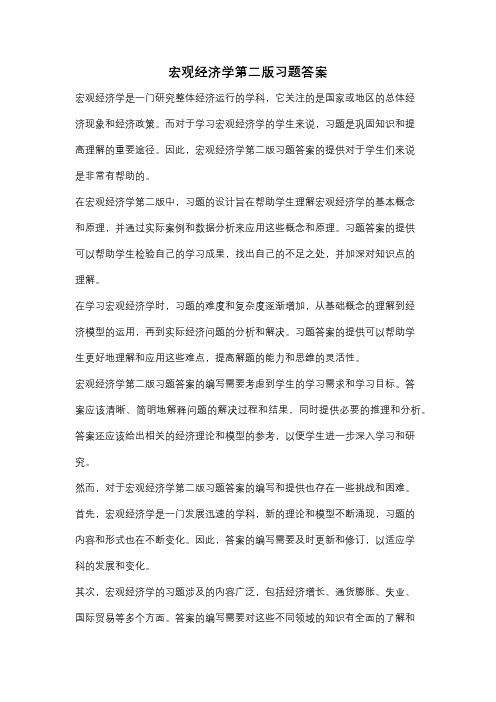
宏观经济学第二版习题答案宏观经济学是一门研究整体经济运行的学科,它关注的是国家或地区的总体经济现象和经济政策。
而对于学习宏观经济学的学生来说,习题是巩固知识和提高理解的重要途径。
因此,宏观经济学第二版习题答案的提供对于学生们来说是非常有帮助的。
在宏观经济学第二版中,习题的设计旨在帮助学生理解宏观经济学的基本概念和原理,并通过实际案例和数据分析来应用这些概念和原理。
习题答案的提供可以帮助学生检验自己的学习成果,找出自己的不足之处,并加深对知识点的理解。
在学习宏观经济学时,习题的难度和复杂度逐渐增加,从基础概念的理解到经济模型的运用,再到实际经济问题的分析和解决。
习题答案的提供可以帮助学生更好地理解和应用这些难点,提高解题的能力和思维的灵活性。
宏观经济学第二版习题答案的编写需要考虑到学生的学习需求和学习目标。
答案应该清晰、简明地解释问题的解决过程和结果,同时提供必要的推理和分析。
答案还应该给出相关的经济理论和模型的参考,以便学生进一步深入学习和研究。
然而,对于宏观经济学第二版习题答案的编写和提供也存在一些挑战和困难。
首先,宏观经济学是一门发展迅速的学科,新的理论和模型不断涌现,习题的内容和形式也在不断变化。
因此,答案的编写需要及时更新和修订,以适应学科的发展和变化。
其次,宏观经济学的习题涉及的内容广泛,包括经济增长、通货膨胀、失业、国际贸易等多个方面。
答案的编写需要对这些不同领域的知识有全面的了解和理解,以确保答案的准确性和可靠性。
此外,宏观经济学第二版习题答案的编写还需要考虑到学生的学习水平和背景。
不同学生的学习能力和理解能力存在差异,答案的编写应该尽量简洁明了,避免使用过于复杂的推理和分析,以便学生能够理解和掌握。
总之,宏观经济学第二版习题答案的提供对于学生们来说是非常有帮助的。
它可以帮助学生巩固知识、提高解题能力,同时也可以帮助学生理解和应用宏观经济学的基本概念和原理。
然而,答案的编写和提供也面临一些挑战和困难,需要考虑到学科的发展和变化,同时也需要考虑到学生的学习水平和背景。
布兰查德《宏观经济学》课后习题及详解(货币政策总结)【圣才出品】
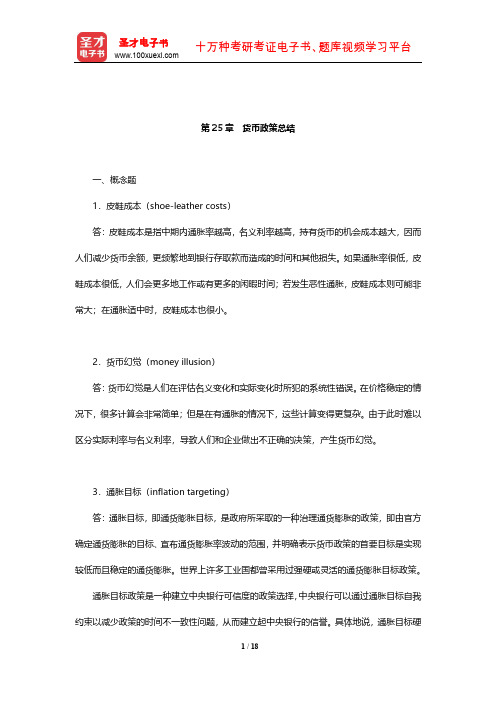
第25章货币政策总结一、概念题1.皮鞋成本(shoe-leather costs)答:皮鞋成本是指中期内通胀率越高,名义利率越高,持有货币的机会成本越大,因而人们减少货币余额,更频繁地到银行存取款而造成的时间和其他损失。
如果通胀率很低,皮鞋成本很低,人们会更多地工作或有更多的闲暇时间;若发生恶性通胀,皮鞋成本则可能非常大;在通胀适中时,皮鞋成本也很小。
2.货币幻觉(money illusion)答:货币幻觉是人们在评估名义变化和实际变化时所犯的系统性错误。
在价格稳定的情况下,很多计算会非常简单;但是在有通胀的情况下,这些计算变得更复杂。
由于此时难以区分实际利率与名义利率,导致人们和企业做出不正确的决策,产生货币幻觉。
3.通胀目标(inflation targeting)答:通胀目标,即通货膨胀目标,是政府所采取的一种治理通货膨胀的政策,即由官方确定通货膨胀的目标、宣布通货膨胀率波动的范围,并明确表示货币政策的首要目标是实现较低而且稳定的通货膨胀。
世界上许多工业国都曾采用过强硬或灵活的通货膨胀目标政策。
通胀目标政策是一种建立中央银行可信度的政策选择,中央银行可以通过通胀目标自我约束以减少政策的时间不一致性问题,从而建立起中央银行的信誉。
具体地说,通胀目标硬化了中央银行的目标,因此有助于避免货币政策的主观随意性,有助于人们树立对物价稳定的信心。
但这一规则同时也使央行失去了政策操作的灵活性,在某些特殊情况下束缚了央行的手脚。
通胀目标具体作法是货币当局事先向社会公众宣布年度物价上涨目标,并通过观察包括货币供应量、失业率、股票指数在内的一系列指标来定期分析经济态势和物价走势,做出适当的货币政策操作,确保实际物价水平维持在公布的通货膨胀预期目标之内。
通货膨胀目标作为一种货币政策策略包含了五个基本因素:①公开宣布中期通货膨胀目标值;②在制度上承诺把物价稳定作为货币政策的首要目标,其他目标置于从属地位;③除了货币总量和汇率外,其他信息变量亦能决定政策工具的操作环境;④货币当局的计划、目标、决议对公众有更多的透明度;⑤中央银行对通货膨胀目标的达到有更多的责任。
布兰查德《宏观经济学》课后习题及详解(金融市场)【圣才出品】
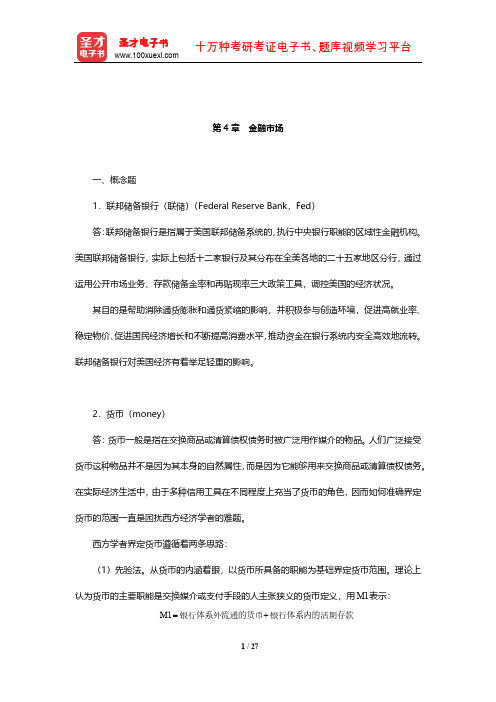
第4章金融市场一、概念题1.联邦储备银行(联储)(Federal Reserve Bank,Fed)答:联邦储备银行是指属于美国联邦储备系统的,执行中央银行职能的区域性金融机构。
美国联邦储备银行,实际上包括十二家银行及其分布在全美各地的二十五家地区分行,通过运用公开市场业务、存款储备金率和再贴现率三大政策工具,调控美国的经济状况。
其目的是帮助消除通货膨胀和通货紧缩的影响,并积极参与创造环境,促进高就业率、稳定物价、促进国民经济增长和不断提高消费水平,推动资金在银行系统内安全高效地流转。
联邦储备银行对美国经济有着举足轻重的影响。
2.货币(money)答:货币一般是指在交换商品或清算债权债务时被广泛用作媒介的物品。
人们广泛接受货币这种物品并不是因为其本身的自然属性,而是因为它能够用来交换商品或清算债权债务。
在实际经济生活中,由于多种信用工具在不同程度上充当了货币的角色,因而如何准确界定货币的范围一直是困扰西方经济学者的难题。
西方学者界定货币遵循着两条思路:(1)先验法。
从货币的内涵着眼,以货币所具备的职能为基础界定货币范围。
理论上M表示:认为货币的主要职能是交换媒介或支付手段的人主张狭义的货币定义,用1银行体系外流通的货币银行体系内的活期存款1M=+理论上认为货币的主要职能是价值贮藏职能的人则主张广义的货币定义,用2M表示:商业银行的储蓄存款商业银行的定期存款。
=++21M M(2)实证法。
由于在理论上长期无法形成共识,许多人转而从实际政策或实验方法角度来认识货币定义。
著名经济学家凯恩斯就主张根据不同的政策用途拟定不同的货币定义。
这一主张为大多数金融当局所接受,各国实际上均从本国货币政策出发给出多种货币定义。
以弗里德曼为代表的另一派经济学家则主张以严格的经济计量学方法测定货币定义。
总之,M作为基本货币的观念已为广大经济学家所接受。
货币的定义在理论界尚未统一,但13.通货(currency)答:通货即是流通中的货币,在商品流通过程中充当一般等价交换物,包括纸币、铸币等有形实体货币和信用货币。
布兰查德《宏观经济学》章节课后习题详解(储蓄、资本积累和产出)【圣才出品】
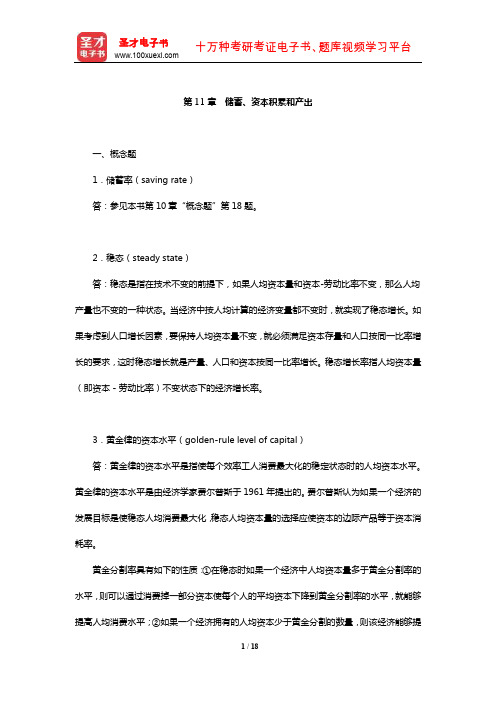
第11章储蓄、资本积累和产出一、概念题1.储蓄率(saving rate)答:参见本书第10章“概念题”第18题。
2.稳态(steady state)答:稳态是指在技术不变的前提下,如果人均资本量和资本-劳动比率不变,那么人均产量也不变的一种状态。
当经济中按人均计算的经济变量都不变时,就实现了稳态增长。
如果考虑到人口增长因素,要保持人均资本量不变,就必须满足资本存量和人口按同一比率增长的要求,这时稳态增长就是产量、人口和资本按同一比率增长。
稳态增长率指人均资本量(即资本-劳动比率)不变状态下的经济增长率。
3.黄金律的资本水平(golden-rule level of capital)答:黄金律的资本水平是指使每个效率工人消费最大化的稳定状态时的人均资本水平。
黄金律的资本水平是由经济学家费尔普斯于1961年提出的。
费尔普斯认为如果一个经济的发展目标是使稳态人均消费最大化,稳态人均资本量的选择应使资本的边际产品等于资本消耗率。
黄金分割率具有如下的性质:①在稳态时如果一个经济中人均资本量多于黄金分割率的水平,则可以通过消费掉一部分资本使每个人的平均资本下降到黄金分割率的水平,就能够提高人均消费水平;②如果一个经济拥有的人均资本少于黄金分割的数量,则该经济能够提高人均消费的途径是在目前缩减消费,增加储蓄,直到人均资本达到黄金分割率的水平。
4.完全基金的社会保障体系(fully funded social security system)答:完全基金是指向工人收税,并把这些税收投资于金融资产,当工人退休时支付本金加利息的一种社会保障体系。
即在任何时候,系统拥有的基金等于人们所交款项的累积额,而且当工人退休时,能够从中领取退休金。
退休人员从现收现付体系中所得取决于人口结构,即退休人员的比例,以及体系制定的税率变化。
在完全基金体系中,工人们储蓄得少,因为他们希望在年迈时获得更多的退休金。
而社会保障体系以工人的名义将税收投资于金融资产。
- 1、下载文档前请自行甄别文档内容的完整性,平台不提供额外的编辑、内容补充、找答案等附加服务。
- 2、"仅部分预览"的文档,不可在线预览部分如存在完整性等问题,可反馈申请退款(可完整预览的文档不适用该条件!)。
- 3、如文档侵犯您的权益,请联系客服反馈,我们会尽快为您处理(人工客服工作时间:9:00-18:30)。
Equating output for some time t in
8*(1.03) =(.84*1.09)*(1.09)
t
8/(.84*1.09)=(1.09/1.03)
t
8.737=(1.058) t =ln(8.737)/ln(1.058) ≈38yrs b. From Chapter 1: US output/worker in 1997=$29,800; China output/per worker in 1996=$700
t t
t
t
29.8*(1.03) =(.7*1.09)*(1.09) t≈65 years
Chapter 2
1. a. False. b. Uncertain: real or nominal GDP. c. True. d. True. e. False. The level of the CPI means nothing. Its rate of change tells us about inflation. f. Uncertain. Which index is better depends on what we are trying to measure—inflation faced by consumers or by the economy as a whole. 2. a. +$100; Personal Consumption Expenditures b. no change: intermediate good c. +$200 million; Gross Private Domestic Fixed Investment d. +$200 million; Net Exports e. no change: the jet was already counted when it was produced, i.e., presumably when Delta (or some other airline) bought it new as an investment. *3. a. Measured GDP increases by $10+$12=$22. b. True GDP should increase by much less than $22 because by working for an extra hour, you are no longer producing the work of cooking within the house. Since cooking within the house is a final service, it should count as part of GDP. Unfortunately, it is hard to measure the value of work within the home, which is why measured GDP does not include it. 4. a. $1,000,000 the value of the silver necklaces. b. 1st Stage: $300,000. 2nd Stage: $1,000,00-$300,000=$700,000. GDP: $300,000+$700,000=$1,000,000. c. Wages: $200,000 + $250,000=$450,000. Profits: ($300,000-$200,000)+($1,000,000-$250,000-300,000) =$100,000+$450,000=$550,000. GDP: $450,000+$550,000=$1,000,000. 5. a. 1998 GDP: 10*$2,000+4*$1,000+1000*$1=$25,000
Answers to End-of-Chapter Questions and Problems
Chapter 1
1. a. True. b. True. c. False. d. True. e. False. f. False. 2. a. US EU Japan 1960-98 ---------3.1% 3.1% 5.8% 1997-99 --------3.8% 2.5% -1.0%
1999 GDP: 12*$3,000+6*$500+1000*$1=$40,000 Nominal GDP has increased by 60%. b. 1998 real (1998) GDP: $25,000 1999 real (1998) GDP: 12*$2,000+6*$1,000+1000*$1=$31,000 Real (1998) GDP has increased by 24%. c. 1998 real (1999) GDP: 10*$3,000+4*$500+1,000*$1=$33,000 1999 real (1999) GDP: $40,000. Real (1999) GDP has increased by 21.2%. d. True.6. a. 1998 base year: Deflator(1998)=1; Deflator(1999)=$40,000/$31,000=1.29 Inflation=29% b. 1999 base year: Deflator(1998)=$25,000/$33,000=0.76; Deflator(1999)=1 Inflation=(1-0.76)/0.76=.32=32% c. Yes 7. a. 1998 real GDP = 10*$2,500 + 4*$750 + 1000*$1 = $29,000 1999 real GDP = 12*$2,500 + 6*$750 + 1000*$1 = $35,500 b. (35,500-29,000)/29,000 = .224 = 22.4% c. Deflator in 1998=$25,000/$29,000=.86 Deflator in 1999=$40,000/$35,500=1.13 Inflation = (1.13 -.86)/.86 = .314 = 31.4%. 8. a. The quality of a routine checkup improves over time. Checkups now may include EKGs, for example. Medical services are particularly affected by this problem due to constant improvements in medical technology. b. You need to know how the market values pregnancy checkups with and without ultra-sounds in that year. c. This information is not available since all doctors adopted the new technology simultaneously. Still, you can tell that the quality adjusted increase will be lower than 20%. *9. a. approximately 2.5% b. 1992 real GDP growth: 2.7%; unemployment rate Jan 92: 7.3%; unemployment rate Jan 93: 7.3% Supports Okun's law because the unemployment rate does not change when the growth rate of real GDP is near 2.5%
--------------------------------------------------------
If history simply repeats itself, the United States might have a short recession (lasting perhaps one year) accompanied by an acceleration in the rate of inflation by about one percentage point. 4. a. Banking services, business services. b. Not only has the relative demand for skilled workers increased but the industries where this effect is the strongest are making up a greater fraction of the economy. 5. 1. Low unemployment might lead to an increase in inflation. 2. Although measurement error certainly contributes to the measured slowdown in growth, there are other issues to consider as well, including the productivity of new research and accumulation of new capital. 3. Although labor market rigidities may be important, it is also important to consider that these rigidities may not be excessive, and that high unemployment may arise from flawed macroeconomic policies. 4. Although there were serious problems with regard to the management of Asian financial systems, it is important to consider the possibility that the flight of foreign capital from these countries worsened the situation by causing a severe stock market crash and exchange rate depreciation. 5. Although the Euro will remove obstacles to free trade between European countries, each country will be forced to give up its own monetary policy. * 6. a. From Chapter 1: US output 1997=$8b; China output 1996=$.84b. Note that China’s output in 1997 is $(.84)*(1.09) b. the future:
